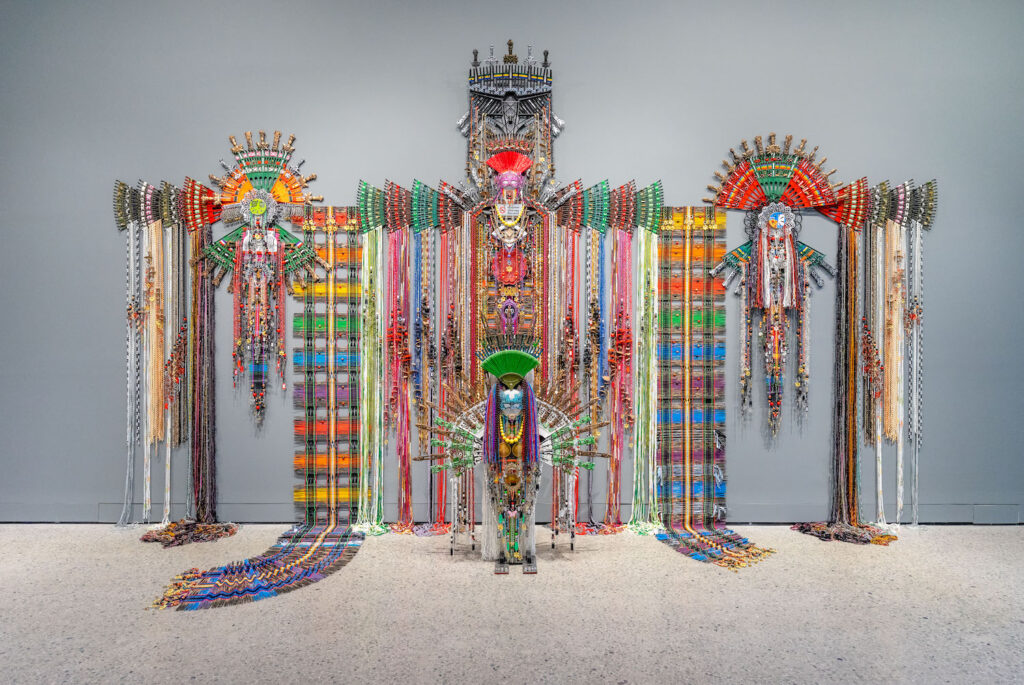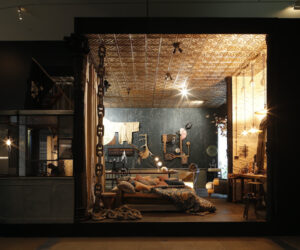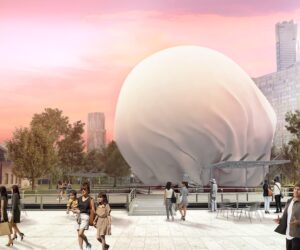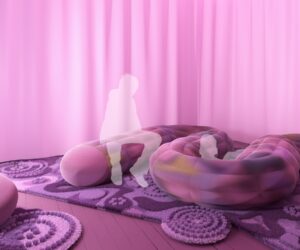Biennale of Sydney Announces Artists, Locations and Initial Programming for 2024 Edition: Ten Thousand Suns
The Biennale of Sydney has announced the artists, locations and initial programming for its 24th edition, titled Ten Thousand Suns, being presented free to the public from 9 March to 10 June 2024.
A major international art festival and the largest contemporary art event of its kind in Australia, the 24th Biennale of Sydney will be presented at Art Gallery of New South Wales, Artspace, Museum of Contemporary Art Australia, and for the first time at Chau Chak Wing Museum at the University of Sydney, UNSW Galleries and at the iconic and recently restored White Bay Power Station.
With the artistic direction led by Cosmin Costinaș and Inti Guerrero, the 24th Biennale of Sydney proposes celebration as both a method and a source of joy, inspired by legacies of collective resistance and coming together to thrive in the face of injustice. With an exhibition of contemporary art at its core, the event draws from multiple histories, voices and perspectives, to explore connected thematic threads, from the celebration of the resurgence of First Nations technologies and knowledges, the history of Islam in Australia, to Queer resilience, and the international expression of Carnivale.
The program also explores the atomic era, a concentrated time of climate alteration through human exploitation, within the context of today’s moment of climate emergency and a refusal to concede to an apocalyptic vision of the future. Marking the Biennale of Sydney’s 50th anniversary year, the 2024 edition challenges Western fatalistic constructions of the apocalypse and embraces a hopeful outlook around a possible future lived in joy, produced in common and shared widely.
The 2024 edition will feature 88 artists and collectives from 47 countries including Australia, Indonesia, Brazil, Ukraine, United States of America, United Kingdom, Mexico, Aotearoa New Zealand, India, and Japan.
Selected artists have practices firmly rooted in diverse communities and artistic vocabularies. Audiences will experience dynamic artworks, large-scale installations and site-specific projects by international artists such as Andrew Thomas Huang, Adebunmi Gbadebo, Pacific Sisters, Martin Wong, Frank Moore, Maru Yacco and Anne Samat, alongside Australian artists including Gordon Hookey, Tracey Moffatt, Serwah Attafuah, William Yang, VNS Matrix, Kirtika Kain, Joel Sherwood Spring and Juan Davila.
As a Visionary Partner, the Fondation Cartier pour l’art contemporain has worked with the Biennale of Sydney to commission 14 First Nations artists, including (but not exclusively) Aboriginal and Torres Strait Islander people, to create new work for the edition.
These artists include Mangala Bai Maravi, Doreen Chapman, Megan Cope, Cristina Flores Pescorán, Freddy Mamani, Dylan Mooney, Orquideas Barrileteras, John Pule, Eric-Paul Riege, Darrell Sibosado, Kaylene Whiskey, Yangamini, and Nikau Hindin in collaboration with Ebonie Fifita-Laufilitoga-Maka, Hina Puamohala Kneubuhl, Hinatea Colombani, Kesaia Biuvanua and Rongomai Gbric-Hoskins.
They will work closely with the inaugural Fondation Cartier pour l’art contemporain First Nations Curatorial Fellow Tony Albert to realise their artworks. This is part of the ongoing partnership between the Fondation Cartier pour l’art contemporain and the Biennale of Sydney, which also includes a creative collaboration with the Sydney Opera House, with details to be announced soon.
“Ten Thousand Suns departs from an acknowledgement of a multiplicity of perspectives, cosmologies, and ways of life that have always woven together the world under the sun,” said Artistic Directors Cosmin Costinaș and Inti Guerrero.
“A multiplicity of suns conveys ambiguous images. It evokes a scorching world, both in several cosmological visions and very much in our moment of climate emergency. But it also conveys the joy of cultural multiplicities affirmed, of First Nations understandings of the cosmos brought to the fore, and of carnivals as forms of resistance in contexts that have surpassed colonial oppression,” they added.
“The 24th Biennale of Sydney works with these different layers of meaning, acknowledging the deep ecological crises derived from colonial and capitalist exploitation while refusing to concede to an apocalyptic vision of the future. The 24th Biennale of Sydney proposes instead solar and radiant forms of resistance that affirm collective possibilities around a future that is not only possible, but necessary to be lived in joy and plenitude,” said Costinaș and Guerrero.
FIRST ARTWORKS AND PROGRAM FOR TEN THOUSAND SUNS ANNOUNCED:
Works being presented for the first time in the recently launched, revitalised heritage spaces of the White Bay Power Station in Sydney’s inner west, include:
- Artist Dylan Mooney, a Yuwi, Torres Strait and South Sea Islander man, is known for his high-impact illustrative style with bright, saturated colour, creating works influenced by history, culture and family. He will create a largescale mural celebrating the life of the late queer, First Nations dancer and activist Malcolm Cole, who led the first Aboriginal float at the 1988 Sydney Gay and Lesbian Mardi Gras Parade. Through this new commission, Mooney will commemorate Cole’s life and activism in the queer and Aboriginal communities.
- Darrell Sibosado is a Bard man whose practice explores the innovative potential of the riji (pearl shell) designs within a contemporary context. Passed down over countless generations, the designs represent the detached scales of Aalingoon, the Rainbow Snake, as he rests on the ocean surface, shedding his scales containing traditional knowledge and beliefs. For the 24th Biennale of Sydney, Sibosado will create a neon work centred around the meticulous preparations and movements orchestrated in harmony with the rich traditions and deeply rooted networks of kinship, obligations and interpersonal relationships that are fostered within Sibosado’s community.
- Australian artist collective VNS Matrix, recognised for spearheading the cyberfeminist movement in the 1990s, present some of their iconic works suspended as banners. Taking the socially provocative relationship between women and technology as their point of departure, their works subversively question discourses of domination and control in the expanding cyber space.
Also marking the first time this space has been used as a location for the Biennale of Sydney, Chau Chak Wing Museum will present works including:
- Mangala Bai Maravi, an artist from the Baiga group in India, works to preserve the traditional tattooing patterns of her people by documenting them through her art. The women in the community are tattooed at various stages throughout their life, a tradition passed down through generations where designs are made entirely from memory and oral history.
- Chinese-American painter Martin Wong was known for his work documenting New York in the 1980s before he passed away from AIDS-related illness in 1999. Nine of Wong’s paintings will be displayed, through which he explores multiple ethnic and racial identities, and celebrates his queer sexuality.
The newly revamped Artspace will showcase works including:
- Diné (Navajo) artist Eric-Paul Riege uses a combination of natural and synthetic materials, including wool, cotton, shells, faux fur, and human hair, to create his signature woven sculptures. Riege continues the Indigenous weaving and jewellery-making traditions inherited within his own family history. At Artspace, the artist will present a series of new works reflecting on the Diné philosophy of hózhó which encompasses the values of beauty, balance, and goodness in all things physical and spiritual. There will also be a large-scale sculptural installation presented at White Bay Power Station.
- American artist Adebunmi Gbadebo works with culturally and historically infused materials to investigate land, matter and memory. Reflecting on her family history, Gbadebo has taken soil from the True Blue plantation in South Carolina, the land her ancestors suffered on as slaves, and named for the indigo that was harvested on the property. For the 24th Biennale of Sydney, the artist will create a series of new ceramic works, incorporating soil from the plantation, and hair collected from African diaspora family connections.
At the Art Gallery of NSW, themes of war and nuclear power feature throughout the exhibition, including:
- Gordon Hookey, a Waanyi artist known for his satire of Australian culture and politics, his witty critique of racism, and his exploration of oral and image-based history-making traditions. For the 24th Biennale of Sydney he presents a painting and video work, referencing instances of nuclear testing which have taken place over the Pacific, using humour and sarcasm to challenge prejudices of First Nations people in Australia.
- Maru Yacco, an important figure in the Japanese LGBTQIA+ community, is known for her brightly coloured artworks depicting characters and avatars that are informed by Japanese popular and sub-culture. For the 24th Biennale of Sydney, Yacco will create a large-scale wallpaper depicting a parade of silhouetted figures, complicating the boundary between performance and vulnerability.
At the Museum of Contemporary Art Australia, several works explore queer narratives and the resilience of the community in the wake of the AIDS epidemic, including:
- Frank Moore, a respected American artist and activist, is known for having created work that offers a surrealist perspective on the queer community in New York. Having passed away from AIDS-related illness in 2002, for the 24th Biennale of Sydney his painting Lullaby will be presented. Depicting a bed covered in buffalo, the work explores themes of sickness, death, the innocence and fantasy of childhood, alongside environmental degradation in America.
- Delhi-born, Sydney-based artist, Kirtika Kain examines how oppressive social hierarchies and power structures have been enforced upon and embodied by generations before her from the perspective of an outsider. The Biennale of Sydney has commissioned Kain to create a ten-metre-long layered canvas, working with materials including cow dung, gold leaf and wax.
Artworks at UNSW Galleries include:
- Melbourne-based, Afghanistan born, visual artist, curator and poet Elyas Alavi examines themes of identity and representation through the complex intersections of race, displacement, gender, religion, and sexuality. For the 24th Biennale of Sydney, Alavi explores the history of Australia’s Afghan cameleers, exploring the knowledge and music they brought with them.
- Joel Sherwood Spring is a Wiradjuri anti-disciplinary artist, who works collaboratively on projects that sit outside established notions of contemporary art and architecture attempting to transfigure spatial dynamics of power through discourse, pedagogies, art, design and architectural practice. For his work DIGGERMODE, the artist has used AI to construct landscapes in the style of Albert Namatjira, being torn apart by mining machinery. The work questions the social and environmental ethics of constructing, storing and sharing images.
A dynamic public program will be presented alongside the artworks, kicking off with the opening night concert Lights On at White Bay Power Station on 8 March 2024. With an outdoor stage curated by Phoenix Central Park, the line-up is headlined by Belgian international dance-pop sensations Charlotte Adigéry and Bolis Pupul, and supported by rising star Vv Pete, electronic producer UTILITY & Friends (including First Nations rap artists T Breezy and Walkerboy), and Aotearoa’s own DJ HALFQUEEN. The night will also see roving performers traversing the halls of White Bay, as well as an indoor dancefloor using El Gran Mono, a traditional Colombian picó sound system and one of the exhibited artworks of the 24th Biennale of Sydney. The dance floor features a line-up of local and interstate DJs curated by the Biennale of Sydney in collaboration with the El Gran Mono team. Tickets are on sale now.
During opening weekend, free performances and art activations will take place, including Spotlight Artist Talks where artists present alongside their works, as well as performances by exhibiting artists including Eric-Paul Riege and Cristina Flores Pescorán. Throughout the three-month exhibition there will be daily free art tours for everyone to enjoy, plus dedicated student workshops, three family days curated by disability arts organisations and practitioners, and regular Wednesday evening contemporary music nights curated by Phoenix Central Park that will be ticketed through a ballot system.
Other program highlights include a new commission by performance artist Tommy Misa titled Working Class Clown inspired by the Samoan political satire tradition of Fale Aitu and the iconoclastic drag scene of Sydney’s yesteryear, as well as the return of the hugely popular cult performance night Queer PowerPoint.
Further public programming and artworks will be released in the lead-up to the Biennale.
The list of artists as part of the 24th Biennale of Sydney (2024) are: Adebunmi Gbadebo (USA) Agnieszka Kurant (Poland / USA) Agnieszka Polska (Poland / Germany) Alberto Pitta (Brazil) Andrew Thomas Huang (USA) Anne Samat (Malaysia / USA) Barrileteros Almas del Viento (Guatemala) Bonita Ely (Australia) Breda Lynch (Ireland) Candice Lin (USA) Chitra Ganesh (USA) Choy Ka Fai (Singapore / Germany) Christopher Myers (USA) Christopher Pease (Minang/Wardandi/Bibbulmun, Australia) Citra Sasmita (Indonesia) Cristina Flores Pescorán (Perú / Netherlands / USA) Darrell Sibosado (Bard/Noongar, Australia) Destiny Deacon (KuKu (Cape York) & Erub/Mer (Torres Strait), Australia) Dhopiya Yunupiŋu (Gumatj/Yolŋu nation, Australia) Diane Burns (Anishinaabe/Chemehuevi, USA) Doreen Chapman (Manyjilyjarra, Australia) Dumb Type (Japan) Dylan Mooney (Yuwi/Meriam Mir/South Sea Islander, Australia) Eisa Jocson (Philippines) El Gran Mono (Colombia / Australia) Elyas Alavi (Hazara, Afghanistan / Australia) with Hussein Shirzad (Afghanistan / Australia); Jimmy Hintons (Australia); John Hintons (Australia) and Alibaba Awrang (Afghanistan / USA) Eric-PaulRiege (Diné/Navajo, USA) Felix de Rooy (Curaçao / Netherlands) Francisco Toledo (Mexico) Frank Bowling (UK / Guyana) Frank Moore (USA) Freddy Mamani (The Plurinational State of Bolivia) Gordon Hookey (Waanyi, Australia) Hayv Kahraman (Iraq / Sweden / USA) I Gusti Ayu Kadek Murniasih (Murni) (Indonesia) Idas Losin (Truku/Atayal, Taiwan) Irene Chou (Hong Kong / Australia) James Eseli (Kala Lagaw Ya/Badhulaig, Torres Strait Islands, Australia) Li Jiun-Yang (Taiwan) Joel Sherwood Spring (Wiradjuri, Australia) John Pule (Niue / Aotearoa New Zealand) Josh Kline (USA) Juan Davila (Chile / Australia) Júlia Côta (Portugal) Kaylene Whiskey (Yankunytjatjara, Australia) Kirtika Kain (India / Australia) Köken Ergun (Turkey / Germany) Kubra Khademi (Afghanistan / France) Lawrence Lek (Malaysia / UK) Leila el Rayes (Australia) MangalaBai Maravi (India) Mariana Castillo Deball (Mexico / Germany) Marie-Claire Messouma Manlanbien (France) Martin Wong (USA) Maru Yacco (Japan) Mauroof Jameel & Hamsha Hussain (Maldives) Megan Cope (Ngugi/Noonuccal, Quandamooka, Australia) Ming Wong (Singapore / Germany) Monira Al Qadiri (Kuwait / Germany) Nádia Taquary (Brazil) Nikau Hindin (Te Rarawa/Ngāpuhi, Aotearoa New Zealand), Ebonie Fifita-Laufilitoga-Maka (Fungamapitoa, Tonga, Aotearoa New Zealand), Hina Puamohala Kneubuhl (Kihalaupoe, Maui, Hawai‘i), Hinatea Colombani (Arioi, Tahiti), Kesaia Biuvanua (Moce, Lau, Fiji), Rongomai Gbric-Hoskins (Te Rarawa/Ngāpuhi, Aotearoa New Zealand) Niño de Elche & Pedro G. Romero (Spain) Orquideas Barrileteras (Guatemala) Özgür Kar (Turkey / Netherlands) Pacific Sisters (Aotearoa New Zealand) Pauletta Kerinauia (Miyartuwi (Pandanus), Tiwi Islands, Australia) Petrit Halilaj (Kosovo / Germany) & Alvaro Urbano (Spain / Germany) Robert Campbell Jnr (Ngaku/Dunghutti, Australia) Rover Joolama Thomas (Kukatja/Wangkajunga, Australia) Sachiko Kazama (Japan) Sana Shahmuradova Tanska (Ukraine) Satch Hoyt (UK / Jamaica) Saule Dyussenbina (Kazakhstan) Segar Passi (Meriam Mir/Dauareb, Torres Strait Islands, Australia) Sergey Parajanov (Armenia / Georgia) Serwah Attafuah (Ashanti, Australia) Simon Soon (Malaysia) Tarryn Gill (Australia) Te Whā a Huna (Tūwharetoa, Aotearoa New Zealand) Tracey Moffatt (Australia) Trevor Yeung (China / Hong Kong) Udeido Collective (West Papua) VNS Matrix (Australia) Weaver Hawkins (England / Australia) Wendy Hubert (Guruma/Yindjibarndi, Australia) William Strutt (UK) William Yang (Australia) Yangamini (Tiwi; Gulumirrgin; Warlpiri; Kunwinjku; Yolŋu; Wardaman; Karajarri; Gurindji; Burarra, Australia) Among others…
Key Dates
5 March 2024 – Media Preview
8 March 2024 – Lights On opening night
6-8 March 2024 – Vernissage (Professional Preview)
9 March – 10 June 2024 – Biennale of Sydney open to the public
Admission is free.
For further information on the Biennale of Sydney, visit biennaleofsydney.art.



